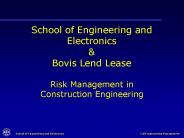INTRODUCTION TO FINANCIAL ENGINEERING - PowerPoint PPT Presentation
1 / 28
Title:
INTRODUCTION TO FINANCIAL ENGINEERING
Description:
Huge number of estimates of covariance between all pairs of available securities ... The hyperbola through A and M cannot be tangent to the efficient frontier ... – PowerPoint PPT presentation
Number of Views:532
Avg rating:3.0/5.0
Title: INTRODUCTION TO FINANCIAL ENGINEERING
1
CHAPTER FOUR Index Models and APT
2
Problems of Markowitz Portfolio Selection
There are some problems for Markowitz portfolio
selection
- Huge number of estimates of covariance between
all pairs of available securities - Vast computing capacity required to resolve an
optimization quadratic programming for large
portfolio - CAPM is a single, static factor model
3
Single-Index Models
- A Mini Case
4
- Regression Model
Firms or unsystematic factor
Exogenous
Macro or systematic factor
5
- Covariance
Unsystematic risk
Systematic risk
6
Market Model
The market is at equilibrium
CAPM
7
- Can you beat the market?
CML
- The hyperbola through A and M cannot be tangent
to the efficient frontier - The point A cannot be located on the efficient
frontier
8
Multi-Index Models
Growth of GDP
Inflation
- The Mini Case
Firms or unsystematic factor
9
- Covariance
10
More About Arbitrage
A riskless arbitrage opportunity exists if and
only if either
- Two portfolios can be created that have identical
payoffs in every state but have different costs
or - Two portfolios can be created with equal costs,
but where the first portfolio has at least the
same payoff as the second in all states, but has
a higher payoff in at least one state or - A portfolio can be created with zero cost, but
which has a non-negative payoff in all states and
a positive payoff in at least one state.
11
- A Mini Case
12
(No Transcript)
13
- Comparing an equally weighted portfolio of the
stocks A, B and C with the stock D
The Portfolio
D
14
- Expected return and standard deviation and
correlation between the portfolio and the stock D
The Portfolio
0.94
D
Is there a reskless arbitrage opportunity
?
15
- Making arbitrage positions
Investing in A
Investing in B
Investing in C
Short sell D
Net position
0
16
Arbitrage Pricing Theory (APT)
Single-Factor APT
Sensitivity of the security is return to the
unexpected change of the macro-economy factor
Pure unsystematic risk
Macro-economy factor the deviation from the
expectation
17
- Well-diversified portfolios and the APT
Variance of macro-economy factor
0
18
- Well-diversified portfolios and the APT (Cont.)
Two diversified portfolio A and B,
- A Mini Case
Short selling 1 million portfolio B Investing
the amount in portfolio A.
Arbitrage
19
Proposition!
20
Security Market Line of APT
!
There is an arbitrage opportunity between
portfolios D and C
21
- APT for individual securities
It holds almost for all individual securities i
and j
22
Multi-Factor APT
Macro-economy factors are the deviations from
their expectations
Diversified portfolios with the following
characteristics
- Factor portfolios
Factor portfolio 1
Factor portfolio 2
23
Replicating portfolio Q weight
- Factor portfolios (cont.)
For factor portfolio 1
For factor portfolio 2
Risk-free security
For a diversified portfolio P
For the replicating portfolio Q
24
- The replicating portfolio Q is the arbitrage
portfolio of the diversified portfolio P
Expected return of P
Expected return of Q
Arbitrage opportunity
Long position of Q
Short position of P
Net profit
25
- Proposition
- The risk premium for a diversified portfolio
is the sum of the contributions from all the
macro-economy factors
Example
26
Multi-Factor APT Models
For a portfolio P
For a security i
The extension of Security Market Line
!
It holds almost for all securities in the markets
27
Difference Between APT and CAPM
Risk free arbitrage vs. risk/return dominants
Support of equilibrium price relationship
APT
CAPM
When equilibrium is violated
Stronger
- many investors make portfolio changes
- each portfolios change is limited
- the aggregation creates a large volume of buying
and selling to restore equilibrium
- many investors make portfolio changes
- each portfolios change is limited
- the aggregation creates a large volume of buying
and selling to restore equilibrium
- implying there exists arbitrage opportunity
- each arbitrageur wants to take as large position
as possible - a few arbitrageurs bring the price pressures to
restore equilibrium
- implying arbitrage opportunity exists
- each arbitrageur wants to take as large position
as possible - a few arbitrageurs bring the price pressures to
restore equilibrium
28
Summary of Chapter Four
- Index Models ? Strict Separation of Systematic
and Unsystematic Risks - CAPM ? A Special Case of Single-Index Model.
Whats the Difference? - How to Beat the Markets?
- The Key of APT Factor Portfolios
- No Arbitrage Equilibrium vs. Risk/Return
Dominance Arguments ? APT vs. CAPM
APT






























